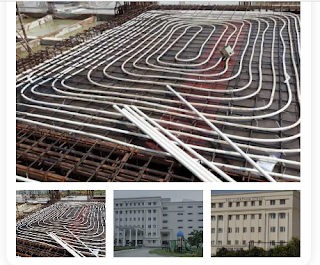Exploring Radiant Cooling and Heating System: Pros and Cons in India
In India, radiant cooling and heating system have gained traction as an innovative solution for climate control in buildings. These systems utilize radiant panels or pipes installed in ceilings, walls or floors to distribute heating or cooling energy evenly throughout a space. By relying on radiant heat transfer rather than forced air circulation, radiant systems offer several advantages, including improved comfort, energy efficiency and indoor air quality. Nevertheless, they also possess certain disadvantages that must be taken into account.
Ceiling radiant flat panels cooling and heating are a popular choice for commercial and residential buildings in India. These panels are installed in the ceiling and use water or refrigerant to absorb or release heat, providing efficient heating or cooling to the space below. One of the main advantages of ceiling radiant flat panels is their ability to deliver uniform temperatures without the need for noisy fans or ductwork. Additionally, these panels can be integrated seamlessly into the building's architecture, preserving aesthetic appeal while ensuring optimal comfort for occupants.
Tiemme radiant cooling and heating systems offer another option for climate control in
Indian buildings. These systems utilize radiant panels or pipes embedded in
ceilings, walls or floors to deliver heating or cooling energy. Tiemme systems
are known for their flexibility and versatility, allowing for customized
solutions to meet the specific requirements of different spaces. With Tiemme
radiant systems, building owners in India can enjoy precise temperature control
and energy efficiency while minimizing the environmental impact associated with
traditional HVAC systems.
Uponor radiant cooling and heating systems are also gaining popularity in India for
their ability to provide efficient and comfortable climate control. These
systems also utilize pipes embedded in floors, walls or ceilings to distribute
heating or cooling energy evenly throughout a space. Uponor systems offer
several benefits, including reduced energy consumption, improved indoor air
quality and enhanced comfort for occupants. Additionally, Uponor radiant
systems can be easily integrated with renewable energy sources such as solar
panels, further reducing the carbon footprint of buildings in India.
While radiant cooling and heating systems offer many
advantages, they also have some limitations that need to be considered. One
potential drawback is the higher upfront cost associated with installation
compared to traditional HVAC systems. Additionally, radiant systems may require
specialized maintenance and servicing, which can add to the overall operational
costs. Another challenge is the slower response time of radiant systems
compared to forced-air systems, particularly in buildings with high thermal
mass.
Moreover, the effectiveness of radiant systems for cooling
and heating can be influenced by factors such as building design, insulation
and climate conditions. In regions with high humidity levels, radiant cooling
systems may struggle to remove moisture from the air, leading to discomfort for
occupants. Additionally, proper design and installation are crucial to ensure
optimal performance and efficiency of radiant systems. Despite these
challenges, the benefits of radiant cooling and heating, including improved
comfort, energy efficiency and indoor air quality, make them a compelling
option for buildings in India looking to enhance their climate control
capabilities.
In the context of India's climate, radiant systems offer
particular advantages. Given the country's diverse climate zones, ranging from
hot and humid in coastal regions to dry and arid in desert areas, radiant
systems can provide tailored climate control solutions. In hot and humid
regions, radiant cooling can help maintain comfortable indoor temperatures while
reducing humidity levels, enhancing occupant comfort. Conversely, in colder
regions, radiant heating can efficiently warm spaces without the need for bulky
radiators or ductwork, offering a more aesthetically pleasing and
space-efficient solution.
However, the adoption of radiant systems in India
faces certain challenges. One such challenge is the lack of awareness and
expertise among building professionals and HVAC contractors regarding the
design, installation and maintenance of radiant systems. Additionally, the
relatively higher initial investment required for radiant systems compared to
traditional HVAC systems may deter some building owners from adopting this
technology. Addressing these challenges will require concerted efforts from
industry stakeholders, including education and training programs to build
capacity among professionals and incentives to encourage the adoption of
energy-efficient building technologies.
Furthermore, the sustainability aspect of radiant systems
aligns well with India's growing focus on environmental conservation and energy
efficiency. By reducing energy consumption and greenhouse gas emissions,
radiant systems contribute to the country's efforts to mitigate climate change
and promote sustainable development. As awareness of the environmental and
economic benefits of radiant systems continues to grow, their adoption is
likely to increase, paving the way for a more sustainable and energy-efficient
built environment in India.
Kayzan Aircon Solutions Pvt. Ltd., as authorized partners of Tiemme and Uponor, stands
at the forefront of supplying radiant cooling and heating systems across India.
Specializing in comprehensive HVAC solutions, the company oversees every aspect
from design to installation and after-sales support. With a dedicated team of
experts and a commitment to quality service, they ensure that clients receive
tailored solutions that meet their specific needs and requirements. By offering
end-to-end services, including system design, installation and ongoing
maintenance, the company aims to provide a seamless and hassle-free experience
for customers, ensuring the efficient operation and longevity of radiant
cooling and heating systems throughout India.

.png)


Comments
Post a Comment